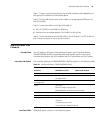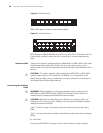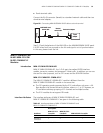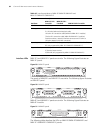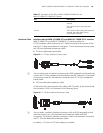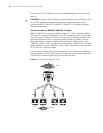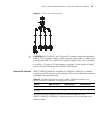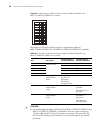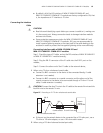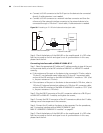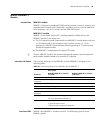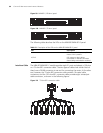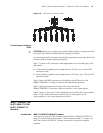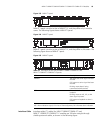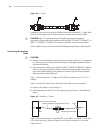
MIM-1E1/MIM-2E1/MIM-4E1/MIM-1E1-F/MIM-2E1-F/MIM-4E1-F Modules 87
■ By default, all of the DIP switches of MIM-1E1/MIM-2E1/MIM-4E1 and
MIM-1E1-F/MIM-2E1-F/MIM-4E1-F modules are factory-configured to ON, that
is, the impedance of E1 interface is 75-ohm.
Connecting the Interface
Cable
c
CAUTION:
■ Read the mark identifying a port before you connect a cable to it, making sure
it is the correct port. Wrong connection tends to damage interface modules
and even the Router;
■ Some protection measures are taken for MIM-1E1/MIM-2E1/MIM-4E1 and
MIM-1E1-F/MIM-2E1-F/MIM-4E1-F modules. Still, you are recommended to
install a special lightning arrester at the input end of the cable leading to the
outdoors in order to protect the line against lightning strikes more efficiently.
Connecting interface cable of MIM-1E1/MIM-2E1 and
MIM-1E1-F/MIM-2E1-F/MIM-4E1-F modules
Step 1: Check the type of E1 cable, and set the DIP switches of MIM-1E1/MIM-2E1
or MIM-1E1-F/MIM-2E1-F module correctly;
Step 2: Plug the DB-15 connector of the E1 cable into the E1/FE1 port on the
module;
Step 3: Connect the other end of the E1 cable to the network device;
1 When using 75-ohm unbalanced coaxial cable,
■ Connect its BNC connector to the device to be connected directly, if cable
extension is not needed;
■ Connect its BNC connector to a coaxial connector and the other end of the
coaxial connector to the device to be connected through a 75-ohm E1 trunk
cable, if cable extension is needed;
c
CAUTION: Connect the local Tx wire in the E1 cable to the remote Rx wire and the
local Rx wire to the remote Tx wire.
Figure 97 Extending an E1 75-ohm unbalanced coaxial cable
■ If the port on the network device to be connected has a 120-ohm port, use a
75-ohm to 120-ohm adapter, or use a 120-ohm cable instead.
2 When using a 120-ohm balanced twisted pair cable,
Router
Network
devices
such as DDN
DB-15
Coaxial connector
BNC
BNC
75-ohm non-balanced coaxial cable
75-ohm E1 trunk cable



